Jiangkai Wu
R-Meshfusion: Reinforcement Learning Powered Sparse-View Mesh Reconstruction with Diffusion Priors
Apr 16, 2025Abstract:Mesh reconstruction from multi-view images is a fundamental problem in computer vision, but its performance degrades significantly under sparse-view conditions, especially in unseen regions where no ground-truth observations are available. While recent advances in diffusion models have demonstrated strong capabilities in synthesizing novel views from limited inputs, their outputs often suffer from visual artifacts and lack 3D consistency, posing challenges for reliable mesh optimization. In this paper, we propose a novel framework that leverages diffusion models to enhance sparse-view mesh reconstruction in a principled and reliable manner. To address the instability of diffusion outputs, we propose a Consensus Diffusion Module that filters unreliable generations via interquartile range (IQR) analysis and performs variance-aware image fusion to produce robust pseudo-supervision. Building on this, we design an online reinforcement learning strategy based on the Upper Confidence Bound (UCB) to adaptively select the most informative viewpoints for enhancement, guided by diffusion loss. Finally, the fused images are used to jointly supervise a NeRF-based model alongside sparse-view ground truth, ensuring consistency across both geometry and appearance. Extensive experiments demonstrate that our method achieves significant improvements in both geometric quality and rendering quality.
MCBlock: Boosting Neural Radiance Field Training Speed by MCTS-based Dynamic-Resolution Ray Sampling
Apr 14, 2025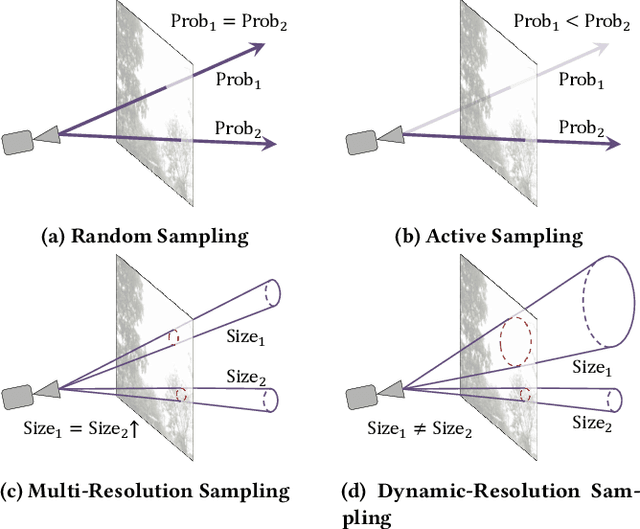



Abstract:Neural Radiance Field (NeRF) is widely known for high-fidelity novel view synthesis. However, even the state-of-the-art NeRF model, Gaussian Splatting, requires minutes for training, far from the real-time performance required by multimedia scenarios like telemedicine. One of the obstacles is its inefficient sampling, which is only partially addressed by existing works. Existing point-sampling algorithms uniformly sample simple-texture regions (easy to fit) and complex-texture regions (hard to fit), while existing ray-sampling algorithms sample these regions all in the finest granularity (i.e. the pixel level), both wasting GPU training resources. Actually, regions with different texture intensities require different sampling granularities. To this end, we propose a novel dynamic-resolution ray-sampling algorithm, MCBlock, which employs Monte Carlo Tree Search (MCTS) to partition each training image into pixel blocks with different sizes for active block-wise training. Specifically, the trees are initialized according to the texture of training images to boost the initialization speed, and an expansion/pruning module dynamically optimizes the block partition. MCBlock is implemented in Nerfstudio, an open-source toolset, and achieves a training acceleration of up to 2.33x, surpassing other ray-sampling algorithms. We believe MCBlock can apply to any cone-tracing NeRF model and contribute to the multimedia community.
PromptMobile: Efficient Promptus for Low Bandwidth Mobile Video Streaming
Mar 20, 2025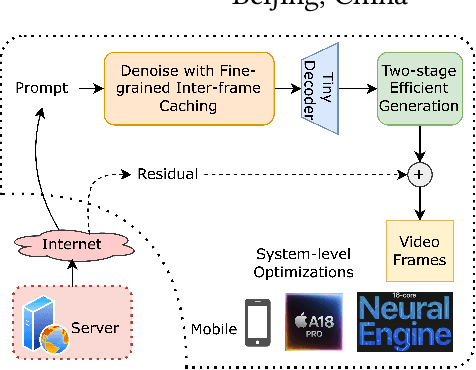
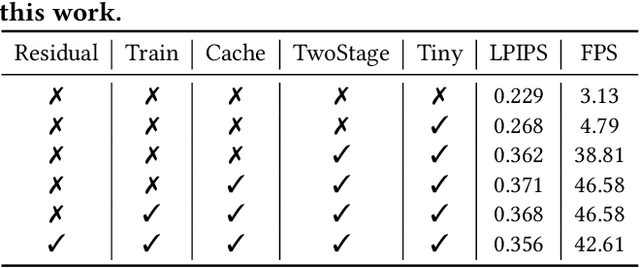
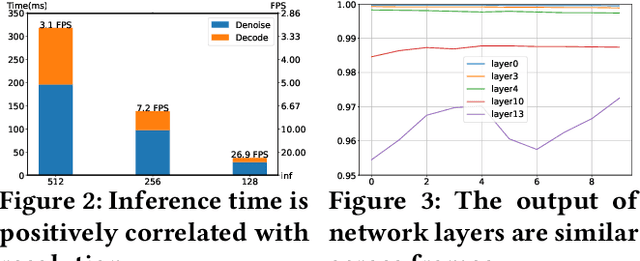

Abstract:Traditional video compression algorithms exhibit significant quality degradation at extremely low bitrates. Promptus emerges as a new paradigm for video streaming, substantially cutting down the bandwidth essential for video streaming. However, Promptus is computationally intensive and can not run in real-time on mobile devices. This paper presents PromptMobile, an efficient acceleration framework tailored for on-device Promptus. Specifically, we propose (1) a two-stage efficient generation framework to reduce computational cost by 8.1x, (2) a fine-grained inter-frame caching to reduce redundant computations by 16.6\%, (3) system-level optimizations to further enhance efficiency. The evaluations demonstrate that compared with the original Promptus, PromptMobile achieves a 13.6x increase in image generation speed. Compared with other streaming methods, PromptMobile achives an average LPIPS improvement of 0.016 (compared with H.265), reducing 60\% of severely distorted frames (compared to VQGAN).
$R^2$-Mesh: Reinforcement Learning Powered Mesh Reconstruction via Geometry and Appearance Refinement
Aug 19, 2024



Abstract:Mesh reconstruction based on Neural Radiance Fields (NeRF) is popular in a variety of applications such as computer graphics, virtual reality, and medical imaging due to its efficiency in handling complex geometric structures and facilitating real-time rendering. However, existing works often fail to capture fine geometric details accurately and struggle with optimizing rendering quality. To address these challenges, we propose a novel algorithm that progressively generates and optimizes meshes from multi-view images. Our approach initiates with the training of a NeRF model to establish an initial Signed Distance Field (SDF) and a view-dependent appearance field. Subsequently, we iteratively refine the SDF through a differentiable mesh extraction method, continuously updating both the vertex positions and their connectivity based on the loss from mesh differentiable rasterization, while also optimizing the appearance representation. To further leverage high-fidelity and detail-rich representations from NeRF, we propose an online-learning strategy based on Upper Confidence Bound (UCB) to enhance viewpoints by adaptively incorporating images rendered by the initial NeRF model into the training dataset. Through extensive experiments, we demonstrate that our method delivers highly competitive and robust performance in both mesh rendering quality and geometric quality.
Promptus: Can Prompts Streaming Replace Video Streaming with Stable Diffusion
May 30, 2024



Abstract:With the exponential growth of video traffic, traditional video streaming systems are approaching their limits in compression efficiency and communication capacity. To further reduce bitrate while maintaining quality, we propose Promptus, a disruptive novel system that streaming prompts instead of video content with Stable Diffusion, which converts video frames into a series of "prompts" for delivery. To ensure pixel alignment, a gradient descent-based prompt fitting framework is proposed. To achieve adaptive bitrate for prompts, a low-rank decomposition-based bitrate control algorithm is introduced. For inter-frame compression of prompts, a temporal smoothing-based prompt interpolation algorithm is proposed. Evaluations across various video domains and real network traces demonstrate Promptus can enhance the perceptual quality by 0.111 and 0.092 (in LPIPS) compared to VAE and H.265, respectively, and decreases the ratio of severely distorted frames by 89.3% and 91.7%. Moreover, Promptus achieves real-time video generation from prompts at over 150 FPS. To the best of our knowledge, Promptus is the first attempt to replace video codecs with prompt inversion and the first to use prompt streaming instead of video streaming. Our work opens up a new paradigm for efficient video communication beyond the Shannon limit.
Identity-Aware Attribute Recognition via Real-Time Distributed Inference in Mobile Edge Clouds
Aug 12, 2020
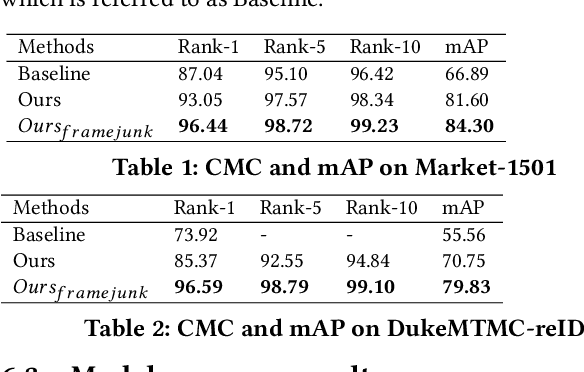


Abstract:With the development of deep learning technologies, attribute recognition and person re-identification (re-ID) have attracted extensive attention and achieved continuous improvement via executing computing-intensive deep neural networks in cloud datacenters. However, the datacenter deployment cannot meet the real-time requirement of attribute recognition and person re-ID, due to the prohibitive delay of backhaul networks and large data transmissions from cameras to datacenters. A feasible solution thus is to employ mobile edge clouds (MEC) within the proximity of cameras and enable distributed inference. In this paper, we design novel models for pedestrian attribute recognition with re-ID in an MEC-enabled camera monitoring system. We also investigate the problem of distributed inference in the MEC-enabled camera network. To this end, we first propose a novel inference framework with a set of distributed modules, by jointly considering the attribute recognition and person re-ID. We then devise a learning-based algorithm for the distributions of the modules of the proposed distributed inference framework, considering the dynamic MEC-enabled camera network with uncertainties. We finally evaluate the performance of the proposed algorithm by both simulations with real datasets and system implementation in a real testbed. Evaluation results show that the performance of the proposed algorithm with distributed inference framework is promising, by reaching the accuracies of attribute recognition and person identification up to 92.9% and 96.6% respectively, and significantly reducing the inference delay by at least 40.6% compared with existing methods.
 Add to Chrome
Add to Chrome Add to Firefox
Add to Firefox Add to Edge
Add to Edge